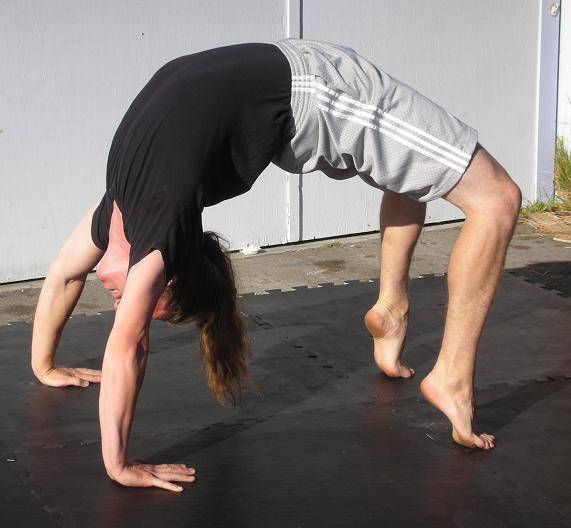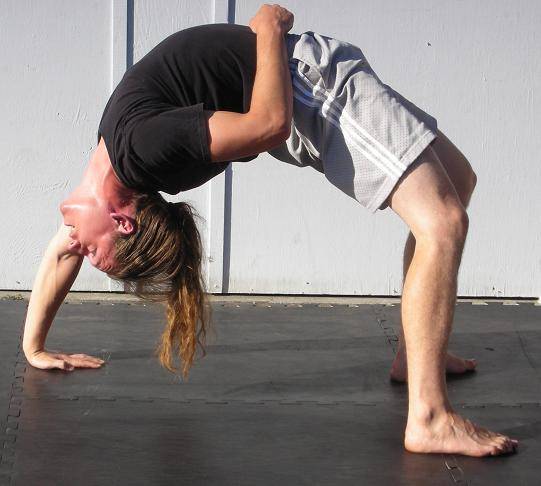In my previous article I covered the wrestler’s bridge and front bridging, but that’s only one side of the bridging game. There is also the gymnast bridge, also known as a hand bridge.
The Gymnast Bridge Is About the Entire Spine
The key difference with the gymnast bridge is that neck strength is no longer the main point. Instead, this move becomes much more about flexibility throughout the entire spine as well as in the shoulders and wrists.
Being able to do a great gymnast bridge will go a long way in keeping you free from back pain and shoulder pain. It’s not a Holy Grail for curing everything, but it can be an important component among others. If you can do a solid bridge, chances are you won’t suffer back pain, or at least not nearly as much.
Become Strong and Stable
When I first started working on the gymnast bridge, I was very inflexible. I could barely raise my body off the ground. But I worked at it and developed a strong and stable position. From that foundation, I’ve gone on to many advanced variations.
To get started, lie with your back on the ground. Your knees should be pointed up with your feet flat on the floor. Your hands should be placed next to your head with fingers pointing parallel to your body and elbows up in the air.
“Being able to do a great gymnast bridge will go a long way in keeping you free from back pain and shoulder pain.”
From this position, push yourself up into the air. This movement has also been called a reverse pushup. Unless you’ve done this or similar work before, chances are you won’t be able to get all the way up into the full bridge (as pictured). That’s fine. Just push up as far as you can go. You can repeat these reverse pushups for reps or just get into the top position and hold for time.
The position you’re working toward is one where your elbows are locked out. But that’s not all. The chest and shoulders also need to open up. When you get to the point that your arms are locked out, then extend your chest more over your hands.

The Ideal Final Bridge Position
The ideal final position is one in which you shoulders are close to straight over your arms, down to the ground. This is a strong position. Here it doesn’t take as much strength as holding something with bent arms, as you’re relying more on your structure rather than strength. This is the key to longer holds.
When you achieve this ideal position, your entire spine is curved. But chances are your spine will not be equally flexible and mobile throughout all your vertebrae. So you may find most of the work is being done by the lumbar spine, while the thoracic remains mostly flat. The ideal is for the entire spine to be curved equally, without all the stress being place in one area. Think about a bridge over water. Real-life bridges are designed to be strong throughout, not just at one single point.
RELATED: Rehabilitation for Lumbar Spine Recovery: The Science and the Truth
Got Flexibility? A Variation to Help You Progress
Here’s one variation that can help you get to that uniformly mobile and strong place. The regular gymnastic bridge position has the heels flat on the floor. But if you raise up onto the balls of your feet, you’ll gain a couple of inches. In doing this, the rest of the move will require a little less flexibility. This is something you can play around with as you develop your bridging skill.

How to Program the Gymnast Bridge
The gymnast bridge can easily be added to any workout. It is best to do after you’re warmed up, as it requires lots of flexibility. Just a set or two done twice a week can be enough to continually improve. Of course, this is also something you can work on a little bit every day.
My recommendation is to build up to a minute hold in good position. Once you have this down, that’s just the beginning. If you’re feeling strong and stable, just raise one arm off the ground and hold. Be sure to work both sides evenly.

And there are many additional harder variations – back bends, kickovers and back, rotating from side to side, walking around, and more (see video below.) All of these continue to increase your flexibility, often in dynamic ways, and thus are great for body control and coordination, too.






